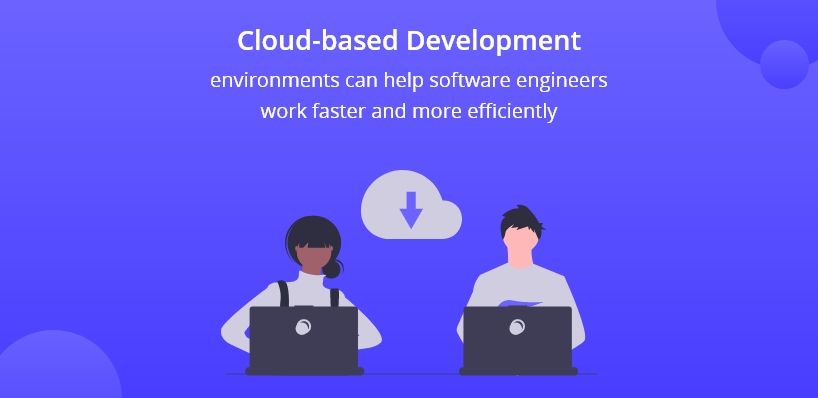Understanding Cloud-based Software Development Environments
Cloud-based software development environments refer to integrated development environments (IDEs) that are hosted on cloud infrastructure rather than on local machines. These cloud-based solutions offer several advantages over traditional development environments, including increased flexibility, scalability, and collaboration. With cloud-based software development environments, developers can access their workspaces from anywhere, at any time, and on any device with an internet connection. This flexibility enables remote teams to collaborate more effectively and efficiently, regardless of their geographical location.
Cloud-based solutions also offer scalability benefits, allowing developers to easily add or remove resources as needed to accommodate changes in project requirements. This scalability is particularly useful for projects with fluctuating resource needs, as it eliminates the need for upfront investment in hardware and infrastructure.
Moreover, cloud-based software development environments facilitate collaboration by providing tools that enable real-time code reviews, pair programming, and version control. These tools help ensure that code is thoroughly tested, reviewed, and documented, leading to higher quality software and fewer bugs.
In summary, cloud-based software development environments offer several benefits over traditional development environments, including increased flexibility, scalability, and collaboration. By leveraging these benefits, developers can improve their productivity, enhance their workflows, and deliver higher quality software.
Key Features to Look for in Cloud-based Software Development Environments
When choosing a cloud-based software development environment, there are several key features to consider. These features can help ensure that the environment meets your specific needs and goals, while also providing a seamless and efficient development experience. First and foremost, version control is a critical feature to look for in a cloud-based software development environment. Version control allows developers to track changes to their code over time, collaborate more effectively, and revert to previous versions if necessary. Git is the most popular version control system, and many cloud-based development environments support Git natively.
Collaboration tools are another essential feature to consider. Cloud-based software development environments should provide tools that enable real-time code reviews, pair programming, and communication between team members. These tools can help ensure that code is thoroughly tested, reviewed, and documented, leading to higher quality software and fewer bugs.
Debugging capabilities are also crucial when choosing a cloud-based software development environment. Developers should look for environments that provide robust debugging tools, including breakpoints, step-through debugging, and variable watches. These tools can help developers identify and fix bugs more efficiently, reducing development time and improving software quality.
Integration with other tools and services is another important consideration. Cloud-based software development environments should provide seamless integration with popular development tools, including build systems, test frameworks, and deployment tools. Additionally, they should integrate with popular project management and collaboration tools, such as Jira, Trello, and Slack.
Finally, security is a critical consideration when choosing a cloud-based software development environment. Developers should look for environments that provide robust security features, including data encryption, access controls, and activity tracking. These features can help ensure that code and data are protected from unauthorized access and tampering.
In summary, when choosing a cloud-based software development environment, developers should look for features that include version control, collaboration tools, debugging capabilities, integration with other tools and services, and robust security features. By considering these features, developers can choose an environment that meets their specific needs and goals, while also providing a seamless and efficient development experience.
Top Cloud-based Software Development Environments: A Comparative Review
Cloud-based software development environments offer numerous benefits over traditional development environments, including increased flexibility, scalability, and collaboration. However, with so many options available, it can be challenging to choose the right one for your specific needs and goals. In this section, we will provide a detailed review of the top cloud-based software development environments, comparing and contrasting their features, strengths, and weaknesses.
GitHub Codespaces
GitHub Codespaces is a cloud-based development environment that provides a seamless and efficient development experience. It offers a range of features, including pre-installed tools, real-time collaboration, and integration with GitHub. One of the key strengths of GitHub Codespaces is its integration with GitHub, which allows developers to quickly and easily access their repositories and collaborate with team members. However, one weakness is that it can be challenging to set up and configure for larger projects.
AWS Cloud9
AWS Cloud9 is a cloud-based development environment that provides a range of features, including pre-installed tools, real-time collaboration, and integration with AWS services. One of the key strengths of AWS Cloud9 is its integration with AWS services, which allows developers to quickly and easily access and deploy their applications. However, one weakness is that it can be challenging to use for developers who are not familiar with AWS services.
Google Cloud Shell
Google Cloud Shell is a cloud-based development environment that provides a range of features, including pre-installed tools, real-time collaboration, and integration with Google Cloud services. One of the key strengths of Google Cloud Shell is its integration with Google Cloud services, which allows developers to quickly and easily access and deploy their applications. However, one weakness is that it can be challenging to use for developers who are not familiar with Google Cloud services.
Comparing the Top Cloud-based Software Development Environments
When comparing the top cloud-based software development environments, there are several factors to consider. First, consider the level of integration with other tools and services. GitHub Codespaces offers seamless integration with GitHub, while AWS Cloud9 and Google Cloud Shell offer integration with their respective cloud services. Next, consider the ease of use and configuration. GitHub Codespaces can be challenging to set up and configure for larger projects, while AWS Cloud9 and Google Cloud Shell are relatively easy to use and configure.
Finally, consider the cost. GitHub Codespaces offers a free tier, while AWS Cloud9 and Google Cloud Shell offer free trials. However, ongoing costs can add up quickly, so it’s essential to consider your specific needs and budget when choosing a cloud-based development environment.
Conclusion
Choosing the right cloud-based software development environment can be challenging, but by considering the key features and comparing the top options, you can find the right one for your specific needs and goals. Whether you choose GitHub Codespaces, AWS Cloud9, Google Cloud Shell, or another option, you’ll be able to take advantage of the increased flexibility, scalability, and collaboration that cloud-based development environments offer.

How to Set Up and Configure a Cloud-based Software Development Environment
Setting up and configuring a cloud-based software development environment can be a straightforward process if you follow the right steps. Here’s a guide on how to get started:
Choosing a Provider
The first step is to choose a cloud-based software development environment provider. Some popular options include GitHub Codespaces, AWS Cloud9, and Google Cloud Shell. When choosing a provider, consider the features and capabilities they offer, as well as the cost.
Creating a New Workspace
Once you’ve chosen a provider, the next step is to create a new workspace. This is where you’ll do your development work. The process for creating a new workspace will vary depending on the provider, but generally involves selecting a template or pre-configured environment, and providing some basic information such as a name and description.
Connecting to Version Control Systems and Other Tools
After creating a new workspace, you’ll need to connect to version control systems and other tools. This is an important step, as it allows you to manage your code and collaborate with team members. To connect to a version control system, you’ll typically need to provide the URL for your repository, as well as your credentials. Once connected, you can pull in your code and start working.
In addition to version control systems, you may also want to connect to other tools such as issue trackers, build systems, and testing frameworks. The process for connecting to these tools will vary depending on the provider and the specific tool, but generally involves providing some basic information such as a URL or API key.
Configuring Your Environment
Once you’ve connected to version control systems and other tools, the next step is to configure your environment. This may involve installing additional packages or libraries, setting up your editor or IDE, and configuring your build and deployment processes. The process for configuring your environment will vary depending on the provider and the specific tools you’re using. However, most providers offer documentation and tutorials to help you get started.
Conclusion
Setting up and configuring a cloud-based software development environment can be a simple and straightforward process. By choosing a provider, creating a new workspace, connecting to version control systems and other tools, and configuring your environment, you can be up and running in no time.

Best Practices for Using Cloud-based Software Development Environments
Cloud-based software development environments offer many benefits, including increased flexibility, scalability, and collaboration. However, to get the most out of these environments, it’s important to follow best practices. Here are some tips for using cloud-based software development environments effectively:
Managing Workspaces
One of the key benefits of cloud-based software development environments is the ability to create and manage multiple workspaces. This allows you to keep your development work organized and separate from other projects. When managing workspaces, be sure to name them clearly and descriptively, and delete any workspaces that are no longer needed. This will help you stay organized and avoid clutter.
Collaborating with Team Members
Cloud-based software development environments make it easy to collaborate with team members, no matter where they are located. To collaborate effectively, be sure to set clear expectations and guidelines for communication and code reviews. Additionally, make use of the collaboration tools provided by your cloud-based software development environment, such as real-time editing and commenting. These tools can help you work together more efficiently and effectively.
Ensuring Data Security
When using cloud-based software development environments, it’s important to ensure the security of your data. This includes protecting your code and other assets from unauthorized access, as well as ensuring the privacy of your team’s communications. To ensure data security, be sure to follow best practices for password management, two-factor authentication, and access controls. Additionally, make use of encryption and other security features provided by your cloud-based software development environment.
Conclusion
By following best practices for managing workspaces, collaborating with team members, and ensuring data security, you can make the most of cloud-based software development environments. These environments offer many benefits, including increased flexibility, scalability, and collaboration, and by following best practices, you can ensure that you’re getting the most out of them.
Challenges and Limitations of Cloud-based Software Development Environments
Cloud-based software development environments offer many benefits, including increased flexibility, scalability, and collaboration. However, there are also some challenges and limitations to consider. Here are some of the most significant issues to keep in mind:
Internet Connectivity Issues
One of the biggest challenges of using cloud-based software development environments is the need for a stable and fast internet connection. Without a reliable internet connection, it can be difficult or impossible to access your development environment, which can lead to delays and productivity losses. To mitigate this challenge, consider using a backup internet connection or working on projects that don’t require real-time access to your cloud-based development environment.
Data Privacy Concerns
Another challenge of using cloud-based software development environments is the need to ensure the privacy and security of your data. When you store your code and other assets in the cloud, you’re entrusting them to a third-party provider, which can raise concerns about data privacy and security. To address these concerns, be sure to choose a reputable cloud-based software development environment provider that has a strong track record of protecting customer data. Additionally, make use of encryption and other security features to ensure that your data is protected.
Cost
Finally, cost can be a significant challenge when using cloud-based software development environments. While these environments offer many benefits, they can also be expensive, especially if you’re using them for large or complex projects. To manage costs, be sure to choose a cloud-based software development environment provider that offers flexible pricing plans. Additionally, consider using free or low-cost tools and services wherever possible, and make use of cost-saving features such as auto-scaling and resource optimization.
Conclusion
While cloud-based software development environments offer many benefits, they also come with some challenges and limitations. By understanding these challenges and taking steps to mitigate them, you can ensure that you’re getting the most out of your cloud-based development environment while also protecting your data and managing costs.

The Future of Cloud-based Software Development Environments
Cloud-based software development environments have revolutionized the way developers work, offering increased flexibility, scalability, and collaboration. As we look to the future, it’s clear that these environments will continue to evolve and improve, offering even more benefits and capabilities to developers. Here are some of the most exciting trends and developments to watch for in the coming years:
Emerging Trends
One of the most significant trends in cloud-based software development environments is the rise of containerization. Containerization allows developers to package their code and dependencies into a single, self-contained unit that can be easily deployed and managed across different environments. This can help to improve consistency, reduce errors, and speed up development cycles. Another trend to watch is the growing use of artificial intelligence and machine learning in cloud-based development environments. These technologies can help to automate many aspects of the development process, from code analysis and testing to deployment and monitoring. This can help to improve efficiency, reduce costs, and free up developers to focus on higher-level tasks.
New Features and Capabilities
As cloud-based software development environments continue to evolve, we can expect to see a range of new features and capabilities. For example, many providers are now offering integrated tools for DevOps, allowing developers to automate the entire software development lifecycle, from code to deployment. Another exciting development is the rise of low-code and no-code development platforms, which allow developers to build applications using visual interfaces and pre-built templates. These platforms can help to reduce the need for specialized coding skills, making it easier for non-technical users to build and deploy their own applications.
Challenges and Opportunities
Of course, the future of cloud-based software development environments is not without its challenges and opportunities. One of the biggest challenges will be managing the growing complexity of these environments, as they become more feature-rich and integrated. At the same time, there are also many opportunities for providers to differentiate themselves and add value for customers. For example, by offering specialized tools and services for specific industries or use cases, providers can help developers to build better, more targeted applications.
Conclusion
The future of cloud-based software development environments is bright, with many exciting trends and developments on the horizon. By staying up-to-date with these trends and taking advantage of the latest features and capabilities, developers can continue to improve their productivity, efficiency, and innovation.
Conclusion: Choosing the Right Cloud-based Software Development Environment for Your Needs
Cloud-based software development environments offer many benefits over traditional development environments, including increased flexibility, scalability, and collaboration. However, with so many options available, it can be challenging to choose the right one for your specific needs and goals. When evaluating different cloud-based software development environments, it’s important to consider factors such as version control, collaboration tools, debugging capabilities, and integration with other tools and services. Some of the top options to consider include GitHub Codespaces, AWS Cloud9, and Google Cloud Shell, each with their own unique features, strengths, and weaknesses.
To set up and configure a cloud-based software development environment, start by choosing a provider that meets your needs and creating a new workspace. Then, connect to version control systems and other tools to streamline your development workflow.
When using cloud-based software development environments, be sure to follow best practices such as managing workspaces effectively, collaborating with team members, and ensuring data security. Be aware of challenges and limitations such as internet connectivity issues, data privacy concerns, and cost.
As we look to the future, we can expect to see emerging trends such as containerization, artificial intelligence, and low-code/no-code development platforms in cloud-based software development environments. By staying up-to-date with these trends and taking advantage of the latest features and capabilities, developers can continue to improve their productivity, efficiency, and innovation.
In conclusion, when choosing a cloud-based software development environment, it’s important to consider your specific needs and goals, as well as factors such as version control, collaboration tools, debugging capabilities, and integration with other tools and services. By following best practices and staying up-to-date with emerging trends, developers can take full advantage of the benefits of cloud-based software development environments and continue to innovate and improve their workflows.

